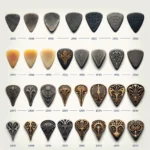The Influence of Guitar Pick Material on Tone Production
When it comes to producing the perfect tone on a guitar, the choice of pick material plays a crucial role. Different materials, such as plastic, nylon, metal, and wood, have unique properties that significantly influence the sound produced. The hardness, flexibility, and texture of the pick material directly impact the way the strings are struck, thus affecting the tone quality.
Plastic picks, known for their versatility and affordability, produce a bright and clear tone, ideal for genres like pop and rock. On the other hand, nylon picks offer a smoother attack and are favored by many jazz and blues guitarists due to their warmer tones. Metal picks are revered for their crisp and sharp sound, making them popular among heavy metal and hard rock players. In contrast, wood picks produce a soft and mellow tone, often preferred in acoustic and folk music.
It’s important to note that the player’s technique and the type of guitar also play a role in shaping the overall tone. However, the significance of pick material should not be underestimated, as it forms the foundation of the sound produced. Experimenting with different pick materials can lead to new sonic possibilities and help guitarists define their unique sound.
In conclusion, the influence of guitar pick material on tone production cannot be overstated. Understanding the sonic characteristics of various materials empowers guitarists to make informed choices that align with their musical style and preferences, ultimately shaping their individual sound.
Exploring the Effect of Different Materials on String Instrument Tone Quality
Exploring the effect of different materials on string instrument tone quality is a crucial aspect of understanding the impact of material on pick tone. The choice of material for making guitar picks, violin bows, and other string instrument accessories can have a significant influence on the final tone produced by the instrument.
When it comes to guitar picks, materials such as nylon, celluloid, metal, and even stone can all produce distinct tones. Nylon picks tend to create a softer, warmer tone, while celluloid picks offer a brighter, crisper sound. Metal picks, on the other hand, produce a sharp and clear tone with enhanced attack, making them ideal for certain playing styles.
Similarly, the material used in crafting violin bows can greatly affect the tone produced by the instrument. Bows made from pernambuco wood are highly regarded for their ability to produce a warm, resonant tone, while carbon fiber bows are known for their clear and focused sound.
Overall, exploring the impact of different materials on string instrument tone quality provides valuable insights for musicians and instrument makers, helping them make informed decisions about the materials they choose to use in their craft.
Material Matters: Understanding the Impact on Pick Tone
When it comes to playing the guitar, the choice of pick material can significantly impact the tone produced. The selection of materials, such as celluloid, nylon, metal, and even wood, can greatly affect the overall sound and playability. Understanding the impact of material on pick tone is crucial for guitarists looking to refine and personalize their sound.
Celluloid picks are known for their warm and rounded tone, providing a familiar feel for many guitarists. On the other hand, nylon picks offer a brighter and snappier tone, ideal for genres that require precise articulation. Metal picks deliver a sharp and aggressive tone, perfect for heavy metal and hard rock styles. Additionally, wooden picks provide a unique, organic sound, favored for acoustic playing due to their warm and natural tonal characteristics.
Experimenting with different pick materials allows guitarists to discover the subtle nuances each type offers. The thickness and shape of the pick further contribute to the tonal characteristics, making the combination of material, thickness, and shape a crucial consideration for achieving the desired sound.
Ultimately, the impact of material on pick tone cannot be understated. Guitarists are encouraged to explore and experiment with various materials to better understand how each affects the overall sound, providing a new level of customization to their playing experience.




